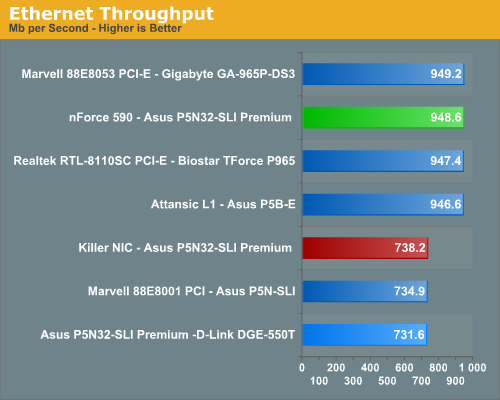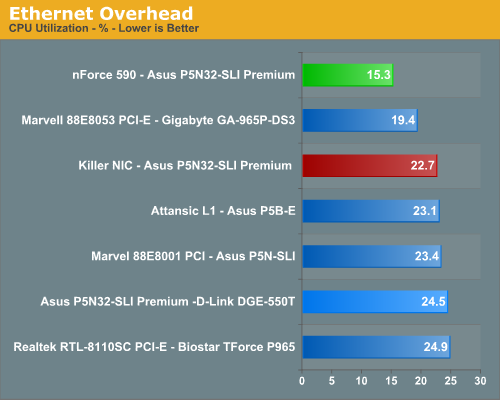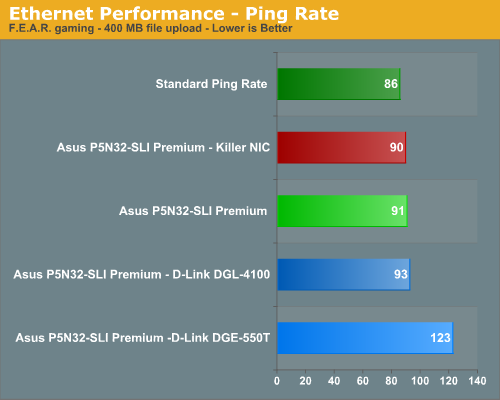BigFoot Networks Killer NIC: Killer Marketing or Killer Product?
by Gary Key on October 31, 2006 2:00 AM EST- Posted in
- Networking
Ethernet NIC Performance
Our current motherboard test suite includes LAN performance measurements and we will utilize this same test today. All of the boards listed utilize PCI or PCI Express based controllers with the only difference being the supplier of the core logic.
The Windows 2000 Driver Development Kit (DDK) includes a useful LAN testing utility called NTttcp. We used the NTttcp tool to test Ethernet throughput and the CPU utilization of the various Ethernet Controllers used on the Intel motherboards.
We set up one machine as the server; in this test, an Intel system with an Intel CSA Gigabit LAN connection. Intel CSA has a reputation for providing fast throughput and is a logical choice for our Gigabit LAN server.
On the server side, we used the following Command Line as suggested by the VIA whitepaper on LAN testing:


No real surprises here as the Killer NIC has a Marvell PHY and utilizes the PCI interface for operation. The throughput rates and CPU utilization of the Killer NIC was very competitive with our other PCI based solutions. However, the NVIDIA nForce 590SLI had the best overall performance numbers in these tests. BigFoot Networks was adamant about the fact they concentrated on lower latency and not improving throughput on the card since most network connections while gaming will not saturate the PCI bus.
Ethernet Outbound Ping Performance
Our final benchmark takes a look at the ping performance of each of our products while playing F.E.A.R. and uploading a 400 MB file to a separate client on another network. Our D-Link DGL-4100 router and the NVIDIA nForce 590SLI include packet prioritization for outbound traffic while gaming. We decided to see how well these solutions stacked up with the Killer NIC that can also prioritize inbound traffic.

All three of our products that advertise packet prioritization are within 3% of each other in the numbers with our D-Link DGE-550T trailing by around 33%. Why a serious gamer would actually want to upload large files while playing online is beyond us but in case you want to then our three solutions provide the capability to do so without an issue. However, be aware that throughput suffered by an average of 44% for the upload file test with our three solutions when compared to the D-Link NIC during testing.
Our current motherboard test suite includes LAN performance measurements and we will utilize this same test today. All of the boards listed utilize PCI or PCI Express based controllers with the only difference being the supplier of the core logic.
The Windows 2000 Driver Development Kit (DDK) includes a useful LAN testing utility called NTttcp. We used the NTttcp tool to test Ethernet throughput and the CPU utilization of the various Ethernet Controllers used on the Intel motherboards.
We set up one machine as the server; in this test, an Intel system with an Intel CSA Gigabit LAN connection. Intel CSA has a reputation for providing fast throughput and is a logical choice for our Gigabit LAN server.
On the server side, we used the following Command Line as suggested by the VIA whitepaper on LAN testing:
Ntttcpr -m 4,0,‹server IP› -a 4 -l 256000 -n 30000
On the client side (the motherboard under test), we used the following Command Line:Ntttcps -m 4,0,‹client IP› -a 4 -l 256000 -n 30000
At the conclusion of the test, we captured the throughput and CPU utilization figures from the client screen.

No real surprises here as the Killer NIC has a Marvell PHY and utilizes the PCI interface for operation. The throughput rates and CPU utilization of the Killer NIC was very competitive with our other PCI based solutions. However, the NVIDIA nForce 590SLI had the best overall performance numbers in these tests. BigFoot Networks was adamant about the fact they concentrated on lower latency and not improving throughput on the card since most network connections while gaming will not saturate the PCI bus.
Ethernet Outbound Ping Performance
Our final benchmark takes a look at the ping performance of each of our products while playing F.E.A.R. and uploading a 400 MB file to a separate client on another network. Our D-Link DGL-4100 router and the NVIDIA nForce 590SLI include packet prioritization for outbound traffic while gaming. We decided to see how well these solutions stacked up with the Killer NIC that can also prioritize inbound traffic.

All three of our products that advertise packet prioritization are within 3% of each other in the numbers with our D-Link DGE-550T trailing by around 33%. Why a serious gamer would actually want to upload large files while playing online is beyond us but in case you want to then our three solutions provide the capability to do so without an issue. However, be aware that throughput suffered by an average of 44% for the upload file test with our three solutions when compared to the D-Link NIC during testing.










87 Comments
View All Comments
Gary Key - Wednesday, November 1, 2006 - link
We have been trying to develop a benchmark for BF2142 and our issues always revolve around the Titan when it is full. ;-) I tried BF2142 right before we ended testing with the Killer NIC and could not tell any difference with it. However, I did not benchmark while we were trying to develop a benchmark. If I get a chance I will go back and try it with the new drivers.soydeedo - Wednesday, November 1, 2006 - link
cool beans. thanks for that quick first impression. i was just curious if it could somehow benefit from the packet optimization etc. anywho, keep us posted should you find something noteworthy with the new drivers. =)goinginstyle - Wednesday, November 29, 2006 - link
Any update on BF2142?Nehemoth - Tuesday, October 31, 2006 - link
Now i just need that anandtech review thishttp://www.hfield.com/wifire.htm">http://www.hfield.com/wifire.htm
yyrkoon - Wednesday, November 1, 2006 - link
Looks like a flat panel, and you'd do better with a 21-23DB gain Andrew, trust me, I've had the last two years to play with both since we've been wireless internet for about that long. We have just now switched (tonight, just got he hardware) to AT&T 'Wi-Max', and it is much much better than our previous provider using 802.11/G. Get this, it doesnt even need a dirrectional, just set it next to a window (such is true in our case), and you're getting an instant 2.52Mbit from a tower 8 miles away.It's pretty dahmed cool, and I didnt believe it myself, until I hooked up a neibors system for him, and he's got it in a window that sits on the opposite side of his house from the tower. Although, from the little technical information the tech support team was able to provide me with, it's only availible in our town, and only if you cant get DSL, supposedly, this is some sort of trial service for them, to determine whether its feasable to setup in other areas *shrug*. Nothing like downloading at 200 KB/s +, seen it swing as high as 800+ KB/s
feelingshorter - Tuesday, October 31, 2006 - link
Buddy, that thing is realistic. Dont tell me you never herd of a directional antenna?!?!? Thats all it is. No its not overpriced because good antennas cost a lot and it does stop your internet from dropping.Frumious1 - Tuesday, October 31, 2006 - link
Only problem is it's completely impractical for laptops where you move around a lot. For desktops, if you want a consistent quality connection, just run the damn wire and be done with it. The fastest wireless 802.11 stuff can't even come close to 100 Mbit for typical use, let alone gigabit!yyrkoon - Tuesday, October 31, 2006 - link
I have to admit, I'm a bit disappointed in you fellas, for not even benching the in-expensive Intel PCI-E NIC http://www.tigerdirect.com/applications/searchtool...">Intel Pro 1000 PCI-E, Or atleast comparring the two. For $40 USD, this card should perform very close, if not better than the $300usd 'snake oil' NIC.
*sigh*
Gary Key - Tuesday, October 31, 2006 - link
We tested the Intel PRO/1000 PT and the Koutech PEN120 PCI-Express Gigabit adapters. Both adapters scored slightly less than the NIVIDIA NIC across the board in our tests so we did not show the results. Both cards support Linux so that is a plus but then again we were reviewing a NIC designed for Windows based gaming.yyrkoon - Wednesday, November 1, 2006 - link
Hmm, guess i missed that review, however, the last review on saw on the Intel PCI, and Onboard Intel solutions (a year or so ago from *ahem* THW, showed both those leading the pack, of course, I guess the killer NIC wasnt availible at that time . . .